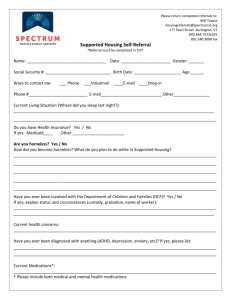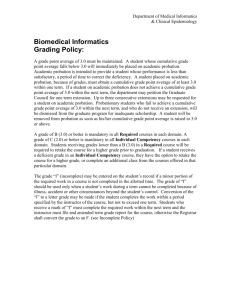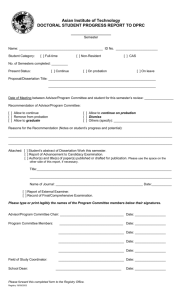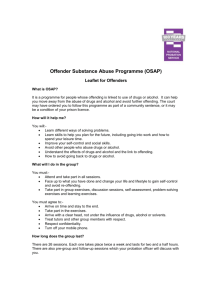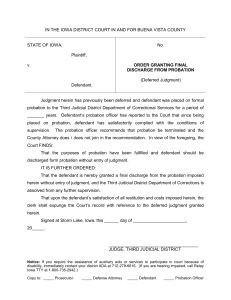probation in north carolina - Robina Institute of Criminal Law
advertisement
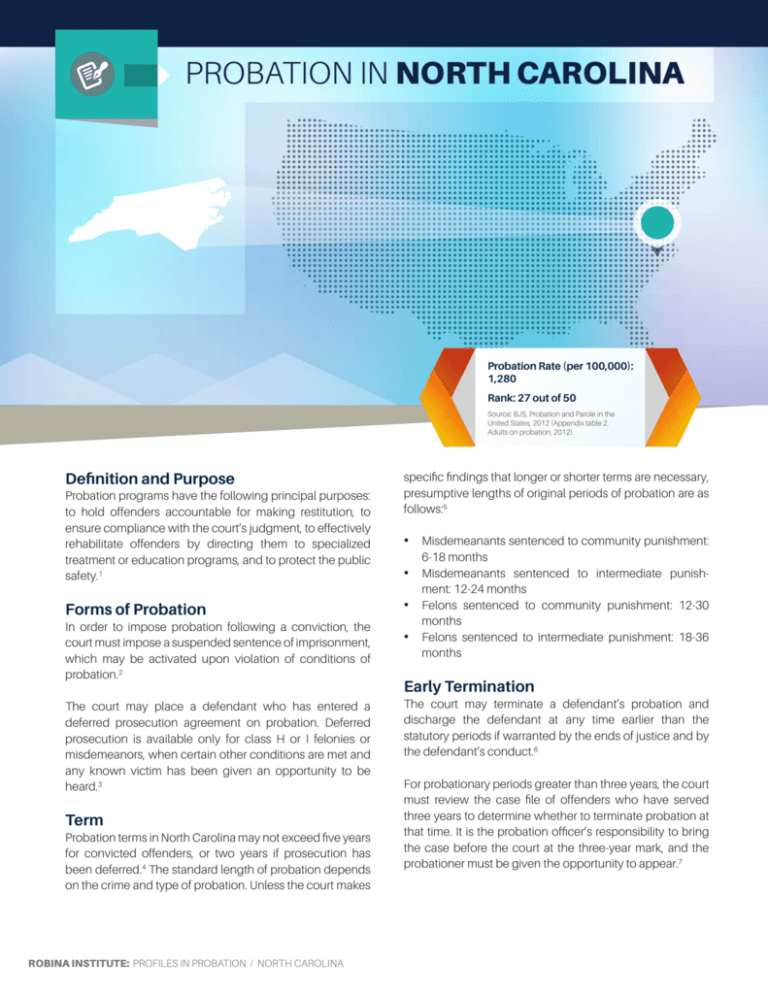
PROBATION IN NORTH CAROLINA Probation Rate (per 100,000): 1,280 Rank: 27 out of 50 Source: BJS, Probation and Parole in the United States, 2012 (Appendix table 2. Adults on probation, 2012). Definition and Purpose Probation programs have the following principal purposes: to hold offenders accountable for making restitution, to ensure compliance with the court’s judgment, to effectively rehabilitate offenders by directing them to specialized treatment or education programs, and to protect the public safety.1 Forms of Probation In order to impose probation following a conviction, the court must impose a suspended sentence of imprisonment, which may be activated upon violation of conditions of probation.2 The court may place a defendant who has entered a deferred prosecution agreement on probation. Deferred prosecution is available only for class H or I felonies or misdemeanors, when certain other conditions are met and any known victim has been given an opportunity to be heard.3 Term Probation terms in North Carolina may not exceed five years for convicted offenders, or two years if prosecution has been deferred.4 The standard length of probation depends on the crime and type of probation. Unless the court makes ROBINA INSTITUTE: PROFILES IN PROBATION / NORTH CAROLINA specific findings that longer or shorter terms are necessary, presumptive lengths of original periods of probation are as follows:5 • Misdemeanants sentenced to community punishment: 6-18 months • Misdemeanants sentenced to intermediate punish- ment: 12-24 months • Felons sentenced to community punishment: 12-30 months • Felons sentenced to intermediate punishment: 18-36 months Early Termination The court may terminate a defendant’s probation and discharge the defendant at any time earlier than the statutory periods if warranted by the ends of justice and by the defendant’s conduct.6 For probationary periods greater than three years, the court must review the case file of offenders who have served three years to determine whether to terminate probation at that time. It is the probation officer’s responsibility to bring the case before the court at the three-year mark, and the probationer must be given the opportunity to appear.7 63 Supervision The probation officer has authority to transfer certain lowrisk misdemeanants from supervised to unsupervised probation once they have made all required payments to the clerk of court, and may be given similar authority by the court for some felony probationers.10 Under the state’s “structured sentencing” scheme (called sentencing guidelines in other states), there is a distinction between “community punishment,” which is less onerous, and “intermediate punishment,” which may include stricter terms and greater intensity of supervision. For example, special probation or assignment to a drug treatment court may be ordered only as part of an intermediate punishment.11 Conditions Courts may set conditions of probation reasonably necessary to ensure that the defendant will lead a lawabiding life and that assist him or her in doing so.12 Regular conditions of probation are presumptively valid. However, if a court imposes an ad hoc special condition of probation, the condition must be reasonably related to the defendant’s rehabilitation.13 Standard conditions include: committing no crime, remaining within the jurisdiction of the court, reporting to a probation officer, making whereabouts known if placed on supervised probation, satisfying child and family obligations, not possessing a weapon without permission, paying a supervision fee, remaining employed or in school and notifying probation of lack of employment, paying court costs, fines, and restitution, paying the costs of appointed counsel, attending treatment, submitting to warrantless searches, refraining from use of controlled substances, and supplying samples of blood, urine, or breath.14 Special conditions may include institutional medical or psychiatric treatment, residence in a facility, restrictions and programs related to alcohol or substance abuse, and community service.15 Enumerated conditions differ for various types of probation such as community punishment, intermediate punishment, and special probation.16 For all community and intermediate punishment sentences, the court may impose short sentences of 2-3 days in jail, adding up to no more than 6 days in any month, and no more than 18 days overall. These short sentences are known as “quick dips.” The court may delegate authority to probation officers to impose quick dips for violations of court-ordered conditions without judicial review, although confinement may be imposed only after administrative review and approval by a Chief Probation Officer, and a number of other procedural protections have been followed. Unless waived, probationers must be notified of their right to seek review in court.17 OF INTEREST If a probationer has served three years of a probationary period greater than three years, North Carolina requires mandatory judicial review of the probationer’s case file. This requires notice to the probationer, who may appear at the hearing. The court may terminate probation after the review. NORTH CAROLINA The court may place the defendant on supervised or unsupervised probation.8 There is also a category of “special probation,” which may include periods of continuous or intermittent confinement in a correctional or treatment facility during the probation term.9 Source: N.C. Gen. Stat. § 15A-1342(d) (2014). When special probation is an authorized sentence, the court may order that probationers serve periods of continuous or noncontinuous confinement during their probation terms. The total of all periods of confinement may not exceed one-quarter of the maximum incarceration sentence for the offense.18 Offenders on supervised probation are required to pay a supervision fee of $40 per month, but the fee may be waived for good cause on motion of the probationer. The court may delegate to the probation officer the responsibility to determine the payment schedule.19 Under the state’s Crime Victims’ Rights Act, victims have the right to be notified of the defendant’s regular conditions of probation or post-release supervision, special or added conditions, supervision requirements, and any subsequent changes. Victims also have the right to be notified of the date when the defendant is terminated or discharged.20 The Division of Adult Corrections also provides services to victims of offenders on probation.21 ROBINA INSTITUTE: PROFILES IN PROBATION / NORTH CAROLINA NORTH CAROLINA 64 Modification of Conditions Extension of Probation Term Probation may be reduced, terminated, continued, or modified at any time by a judge entitled to sit in the court which imposed probation. Modification of probation in response to a violation requires notice and a hearing, but this hearing may be held without the probationer present if sufficient efforts have been made to give notice.22 A probationer must be given a written statement setting forth the modification.23 With notice and a hearing, the court may also extend the period of probation for good cause up to the maximum time allowable.24 With consent of the defendant, the court may extend the period of probation so that the defendant may complete a program of restitution or to allow the defendant to continue medical or psychiatric treatment ordered as a condition of probation. This period cannot exceed three years beyond the original period of probation, and must be ordered only in the last six months of the original probation period.25 Grades of Offenses in North Carolina • North Carolina grades felonies in a “felony punishment chart,” which many other states would call a sentencing guidelines grid. The punishment chart has been enacted into statutory law. Authorized penalties are determined according to the grade of felony (A to I) and the offender’s “prior record level” (I to VI). At each offense level and prior record score, presumptive, mitigated, and aggravated sentencing ranges are set out. The punishment chart sets forth only minimum sentencing ranges, however; maximum sentences must be computed with reference to separate tables. For the lowest grade of felonies, for offenders with no or modest criminal histories, the felony punishment chart authorizes only community punishments or intermediate punishments. That is, prison sentences are impermissible by statute in such cases. For misdemeanors, sentence ranges are established by a “misdemeanor punishment chart,” enacted as a statute, which sets out minimum and maximum authorized penalties according to class of misdemeanor offense (A1, 1, 2, or 3) and “prior conviction level” (I to III). Authorized punishment durations range from 1 to 150 days. For most first offenders, and some offenders with low criminal history scores, the misdemeanor chart authorizes only community punishments or intermediate punishments. Sources: N.C. Gen. Stat. Ann. § 15A-1340.17 (2014); N.C. Gen. Stat. Ann. § 15A-1340.23 (2014). ROBINA INSTITUTE: PROFILES IN PROBATION / NORTH CAROLINA Grounds for Probation Revocation Violation of select conditions, but not all, may result in revocation of probation. Violations that trigger revocation include commission of a new crime or absconding or avoiding supervision. For violation of other conditions of probation, revocation may only occur after two 90-day periods of incarceration have been imposed for previous violations.26 Revocation Procedures If a probationer is arrested for a violation, he must be taken without unnecessary delay before a judicial official to have conditions of release pending a revocation hearing set. A preliminary probable cause hearing must also be conducted, at which the probationer has a right to appear and speak on his own behalf, present relevant information and, on request, personally question adverse informants. This hearing, and the revocation hearing that follows it, may be waived.27 At the revocation hearing, evidence must be disclosed to the probationer, the probationer may speak on his or her own behalf, present evidence, and crossexamine witnesses. The probationer has a right to retained or appointed counsel.28 Under the state constitution, victims have the right to be informed of and to be present at court proceedings of the accused.29 Under the state’s Crime Victims’ Rights Act, victims have the right to be notified of any hearing to revoke, continue, modify, or terminate probation, and to be informed of the outcome of the hearing.30 Legal Standard for Revocation To support revocation, the evidence of a violation must “reasonably satisfy” the judge in the exercise of his or her sound discretion that the defendant has willfully or without lawful excuse violated a valid condition of probation. The court’s decision must take account of the law and the particular circumstances of the case, and be directed by “the reason and conscience” of the judge to a “just result.” The court is required to make findings of fact demonstrating that it considered the evidence offered at a probation revocation hearing, although a failure to make findings does not constitute an abuse of discretion.31 Revocation and Lesser Sanctions If a probationer violates a condition of probation, the court may continue the defendant on probation, with or without modifying the conditions, may place the defendant on special probation or, if continuation, modification, or special probation is not appropriate, may revoke the probation and activate the suspended sentence imposed at the time of initial sentencing, if any, or may order that charges as to which prosecution has been deferred be brought to trial. The court has authority to reduce the originally suspended prison sentence before it is activated, but must do so within the constraints of the state’s structured sentencing laws (called “sentencing guidelines” in other states).32 For most conditions of probation, a first or second violation may result in confinement for a period of up to 90 days.33 Appeal When a district court judge finds a violation of probation and activates a sentence or imposes special probation, the defendant may appeal for a de novo revocation hearing. However, if the defendant waives a revocation hearing, the findings and revocation consequences cannot be appealed.34 When a superior court judge revokes the defendant’s probation, the defendant may appeal to the Court of Appeals.35 The court’s finding of a violation, if supported by competent evidence, will not be overturned absent a showing of manifest abuse of discretion.36 END NOTES 1 N.C. Gen. Stat. Ann. § 15A-1343.2(b) (2014). 19 N.C. Gen. Stat. Ann. § 15A-1343(c1), (g) (2014). 2 N.C. Gen. Stat. Ann. § 15A-1342(c) (2014). 20 N.C. Gen. Stat. Ann. § 15A-837(a)(1), (8) (2014). 3 N.C. Gen. Stat. Ann. § 15A-1341(a1) (2014). 4 N.C. Gen. Stat. Ann. § 15A-1342(a) (2014). 5 N.C. Gen. Stat. Ann. § 15A-1343.2(d) (2014). N.C. Adult Correction Victim Unit, Victim Services for Prison, Probation, and Parole, N.C. Dep’t Pub. Safety (2014), https:// www.ncdps.gov/Index2.cfm?a=000003,002144,002150. 6 N.C. Gen. Stat. Ann. § 15A-1342(b) (2014). 7 8 9 N.C. Gen. Stat. Ann. § 15A-1342(d) (2014). N.C. Gen. Stat. Ann. § 15A-1341(b) (2014). N.C. Gen. Stat. Ann. § 15A-1351(a) (2014). 10 11 12 N.C. Gen. Stat. Ann. § 15A-1343(g) (2014). N.C. Gen. Stat. Ann. § 15A-1340.11 (2014). N.C. Gen. Stat. Ann. § 15A-1343(a) (2014). N.C. Gen. Stat. § 15A-1343(b1)(10); State v. Lambert, 553 S.E.2d 71, 77 (N.C. App. 2001). 21 22 N.C. Gen. Stat. Ann. § 15A-1344 (2014). 23 N.C. Gen. Stat. Ann. § 15A-1343(c) (2014). 24 N.C. Gen. Stat. § 15A-1344(d) (2014). 25 N.C. Gen. Stat. § 15A-1342(a) (2014). 26 N.C. Gen. Stat. § 15A-1344(a) (2014). 27 N.C. Gen. Stat. Ann. § 15A-1345 (2014). 28 Id. 29 N.C. Const. art. I, § 37(1)(a). 13 14 N.C. Gen. Stat. Ann. § 15A-1343(b) (2014). 15 N.C. Gen. Stat. Ann. § 15A-1343(b1) (2014). N.C. Gen. Stat. Ann. §§ 15A-1343(a1), and (b4); 15A-1351 (2014). 16 N.C. Gen. Stat. §§ 15A-1343(a1)(3); 15A-1343.2(e)(5), (f)(6) (2014). See also Jamie Markham, Quick Dips, N.C. Crim. L.: U.N.C. Sch. Gov’t Blog (Nov. 3, 2011), http://nccriminallaw.sog. unc.edu/?p=3023. 17 18 30 N.C. Gen. Stat. Ann. § 15A-837(a)(2)–(3) (2014). 31 E.g., State v. Belcher, 619 S.E.2d 567, 570 (N.C. Ct. App. 1982). 32 N.C. Gen. Stat. Ann. § 15A-1344 (2014). 33 N.C. Gen. Stat. Ann. § 15A–1344(d2) (2014. 34 N.C. Gen. Stat. Ann. § 15A-1347 (2014). 35 N.C. Gen. Stat. Ann. § 15A-1347 (2014). State v. Young, 660 S.E.2d 574, 576 (N.C. Ct. App. 2008) (citing State v. Guffey, 116 S.E.2d 148 (N.C. 1960)). 36 N.C. Gen. Stat. § 15A-1351 (2014). ROBINA INSTITUTE: PROFILES IN PROBATION / NORTH CAROLINA
